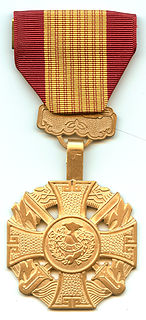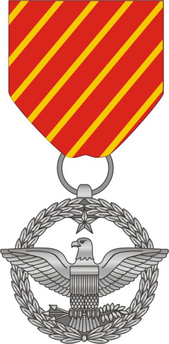The Commendation Medal is a mid-level United States military decoration presented for sustained acts of heroism or meritorious service. Each branch of the United States Armed Forces issues its own version of the Commendation Medal, with a fifth version existing for acts of joint military service performed under the Department of Defense.

The Republic of Vietnam Gallantry Cross also known as the Vietnamese Gallantry Cross or Vietnam Cross of Gallantry is a military decoration of the former Government of South Vietnam. The medal was created on August 15, 1950 and was awarded to military personnel, civilians, and Armed Forces units and organizations in recognition of deeds of valor or heroic conduct while in combat with the enemy.

The Defense Meritorious Service Medal (DMSM) is an award bestowed upon members of the United States military by the United States Department of Defense. In the order of precedence of the United States Armed Forces, it is worn between the Purple Heart and the Meritorious Service Medal. The medal is awarded in the name of the Secretary of Defense to members of the Armed Forces who, while serving in a joint activity, distinguish themselves by non-combat outstanding achievement or meritorious service, but not of a degree to warrant award of the Defense Superior Service Medal.

The Valorous Unit Award (VUA) is the second highest United States Army unit decoration which may be bestowed upon an Army unit after the Presidential Unit Citation (PUC). The VUA is awarded by the United States Army to units of the United States Armed Forces or cobelligerent nations which display extraordinary heroism in action against an armed enemy of the United States on or after 3 August 1963. The unit degree of heroism required is considered the equivalent of the individual degree of heroism required for the Silver Star which is awarded for gallantry in action.

An oak leaf cluster is a ribbon device to denote preceding decorations and awards consisting of a miniature bronze or silver twig of four oak leaves with three acorns on the stem. It is authorized by the United States Armed Forces for a specific set of decorations and awards of the Department of Defense, Department of the Army, and Department of the Air Force.
The Vietnam Service Medal is a military award of the United States Armed Forces established on 8 July 1965 by order of President Lyndon B. Johnson. The medal is awarded to recognize service during the Vietnam War by all members of the U.S. Armed Forces provided they meet the award requirements.
The Air Force Outstanding Unit Award is one of the unit awards of the United States Air Force. It was established in 1954 and was the first independent Air Force decoration created. The Air Force Longevity Service Award would follow in 1957 with most of the standard Air Force awards established in the early to mid 1960s.
A "V" device is a metal 1⁄4-inch (6.4 mm) capital letter "V" with serifs which, when worn on certain decorations awarded by the United States Armed Forces, distinguishes an award for heroism or valor in combat instead of for meritorious service or achievement.
A Noncommissioned Officer Professional Development Ribbon is an award presented by the United States Army and Air Force to recognize those noncommissioned officers who have completed a prescribed leadership course at an NCO training school. The Navy, Marine Corps, and Coast Guard have no equivalent to the Noncommissioned Officer Development Ribbon.
The Air Force Meritorious Unit Award or (MUA) is a mid level unit award of the United States Air Force. Established in 2004, the award recognizes those units who demonstrate exceptionally meritorious conduct in direct support of combat operations. Eligible service is retroactive to 11 September 2001.
The Air Force Expeditionary Service Ribbon (AFESR) is a military award of the United States Air Force which was first created in June 2003. The ribbon is awarded to any member of the Air Force who completes a standard contingency deployment.
The Air Force Longevity Service Award is a military award of the United States Air Force established by Air Force General Order 60, on 25 November 1957 by General Thomas D. White, Air Force Chief of Staff. The award was primarily created as an air force equivalent to the service stripes used by other branches of the United States military to denote years of military service. The award is retroactive to the establishment of the U.S. Air Force as an independent service in September 1947. The ribbon is also retroactive for any service with the U.S. Army Air Forces, U.S. Army Air Corps, or U.S. Army Air Service prior to the creation of the U.S. Air Force as a separate service as long as the serviceman was on active duty on or after 18 September 1947.

The Iraq Campaign Medal (ICM) is a military award of the United States Armed Forces which was created by Executive Order 13363 of U.S. President George W. Bush on 29 November 2004, and became available for general distribution in June 2005. The medal was designed by the U.S. Army Institute of Heraldry and was awarded during the Iraq War, from 19 March 2003 to 31 December 2011.
The Outstanding Airman of the Year Ribbon is a military award of the United States Air Force which was created on February 21, 1968 by order of Secretary of the Air Force Harold Brown. The first presentation of the award was in June 1970. The Outstanding Airman of the Year Ribbon is the highest personal ribbon award of the United States Air Force.

A Marksmanship Ribbon device is primarily a miniature metal rifle, pistol, target, service star, or letter E or S which may be worn if authorized on a Marksmanship Ribbon awarded to members of the United States Coast Guard, United States Air Force, and United States Navy.

The Republic of Vietnam Civil Actions Medal also known as the Vietnam Civil Actions Medal or Civil Actions Medal, is a military decoration of the former South Vietnamese government (1955–75). The medal was created on May 12, 1964 during the Vietnam War. The Civil Actions Medal was awarded to the South Vietnamese military and its allies' military personnel or units that performed outstanding achievements in the field of civil affairs. The medal was awarded in two classes, with the first-class intended for commissioned officers and the second class for enlisted personnel. Individuals who were cited received the medal, ribbon, and a citation.
The NATO Medal is an international military decoration which is awarded to various militaries of the world under the authority of the North Atlantic Treaty Organization (NATO). It is manufactured by Eekelers-Centini Intl, of Hemiksem, Belgium.
Awards and decorations of the United States Department of the Air Force are military decorations which are issued by the Department of the Air Force to airmen of the United States Air Force and guardians of the United States Space Force and members of other military branches serving under Air Force and Space Force commands.

The Air Force Combat Action Medal (AFCAM) is a decoration of the United States Air Force and United States Space Force to recognize airmen and guardians for active participation in ground or air combat.
The Air Force Special Duty Ribbon is a ribbon that is only awarded by the United States Air Force. Established 4 September 2014 by the Secretary of the Air Force,







